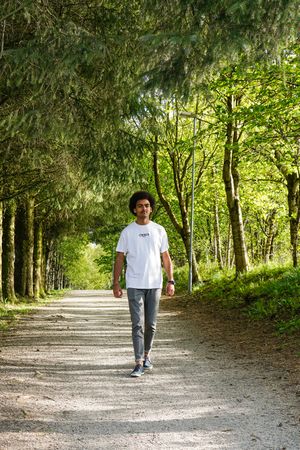Gait Definitions
Introduction[edit | edit source]
Human gait depends on a complex interplay of major parts of the nervous, musculoskeletal and cardiorespiratory systems.
- The individual gait pattern is influenced by age, personality, mood and sociocultural factors.
- The preferred walking speed in older adults is a sensitive marker of general health and survival.
- Safe walking requires intact cognition and executive control.
- Gait disorders lead to a loss of personal freedom, falls and injuries and result in a marked reduction in the quality of life[1].
Definitions[edit | edit source]
Gait - the manner or style of walking.
Gait Analysis -
An analysis of each component of the three phases of ambulation is an essential part of the diagnosis of various neurologic disorders and the assessment of patient progress during rehabilitation and recovery from the effects of neurologic disease, a musculoskeletal injury or disease process, or amputation of a lower limb.
Gait speed
- The time it takes to walk a specified distance, usually 6 m or less. Slower speeds correlate with an increased risk of mortality in geriatric patients.[2]
- Normal walking speed primarily involves the lower extremities, with the arms and trunk providing stability and balance.
- Faster speeds - body depends on the upper extremities and trunk for propulsion, balance and stability with the lower limb joints producing greater ranges of motion.[3]
The gait cycle is a repetitive pattern involving steps and strides[4]
A step is one single step
A stride is a whole gait cycle.
Step time - time between heel strike of one leg and heel strike of the contralateral leg[4].
Step width - the mediolateral space between the two feet[4].
The demarcation between walking and running occurs when
- periods of double support during the stance phase of the gait cycle (both feet are simultaneously in contact with the ground) give way to two periods of double float at the beginning and the end of the swing phase of gait (neither foot is touching the ground)[5].
References[edit | edit source]
- ↑ Pirker W, Katzenschlager R. Gait disorders in adults and the elderly. Wiener Klinische Wochenschrift. 2017 Feb 1;129(3-4):81-95.Available from:https://www.ncbi.nlm.nih.gov/pmc/articles/PMC5318488/ (last accessed 27.6.2020)
- ↑ Medical dictionary Gait speed Available from: https://medical-dictionary.thefreedictionary.com/gait+speed (last accessed 28.6.2020)
- ↑ Shultz SJ et al. Examination of musculoskeletal injuries. 2nd ed, North Carolina: Human Kinetics, 2005. p55-60.
- ↑ 4.0 4.1 4.2 Loudon J, et al. The clinical orthopedic assessment guide. 2nd ed. Kansas: Human Kinetics, 2008. p.395-408.
- ↑ The biomechanics of running Tom F. Novacheck Motion Analysis Laboratory, Gillette Children’s Specialty Healthcare, Uni6ersity of Minnesota, 200 E. Uni6ersity A6e., St. Paul, MN 55101, USA Received 25 August 1997; accepted 22 September 1997 Available from:







